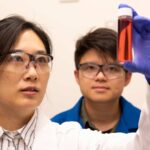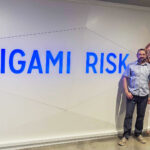
ASU software engineers honor late cyclist with “dash cam” for bikes
Fulton Schools faculty and students assist the Rob Dollar Foundation to make streets safer for cyclists

It was all Rob’s idea.
In the months before his death, avid cyclist Rob Dollar spoke frequently with his father, John Dollar, about his desire to start a foundation to promote safer riding conditions. When Dollar was tragically killed by a motorist at the age of 36 while riding on South Mountain in Phoenix, John knew what he had to do.
The Rob Dollar Foundation was born, and it has one simple objective.
“We want to save lives,” John says. “If we can save even one life, our mission will be a success.”
The foundation offers free bike safety courses, has worked with the city of Phoenix to develop road signage and hosts an annual ride in Rob’s honor.
Now, the Rob Dollar Foundation is collaborating with software engineering faculty and students in the School of Computing and Augmented Intelligence, part of the Ira A. Fulton Schools of Engineering at Arizona State University, on a project called CycleSafe.
Described as a “dash cam” for bikes, CycleSafe is a device that attaches to handlebars and can connect to a mobile phone. When a car comes too close to a cyclist, CycleSafe activates and records information about the encounter, capturing both data and images of the vehicle and its license plate.

From left to right: Manoj Dara, Rhishabh Hattarki, Akansh Kumar and Akshata Kodagnur, who graduated from ASU with software engineering master’s degrees in spring 2024, show the CycleSafe application operating on a mobile phone. Completed under the supervision of Robert Heinrichs, an associate teaching professor of computer science and engineering in the Fulton Schools, the application records data, including images, from dangerous encounters between vehicles and bikes. Photographer: Aisha Kaddi/ASU
Three feet is the law
Robert Heinrichs is an associate teaching professor of computer science and engineering in the Fulton Schools. At the height of the COVID-19 pandemic, Heinrichs took up cycling to stay in shape while working from home. He later connected with John Dollar at an event organized by the foundation.
John Dollar had already been exploring the concept of creating an event-recording device for bikes. He wanted a way to collect data that could be presented to lawmakers to stimulate conversation about better road safety. Arizona state law requires drivers to give cyclists at least three feet of space when passing in vehicles.
“There is very little data available to the public about conditions cyclists face on the road,” John says. “We wanted a way to be able to speak to people like city planners about streets that are especially dangerous and might need protected bike lanes, or places that could benefit from more law enforcement.”
When John met Heinrichs, the foundation had the CycleSafe device in development with Daniel Latt, an associate professor of orthopedics at the University of Arizona. But the team wanted better software to run with the device.
Heinrichs put together a group of software engineering master’s degree students who created a new application for CycleSafe as a capstone project, a comprehensive piece of work completed over two semesters. The team demonstrated their software at the spring 2024 Innovation Showcase held on the ASU Polytechnic campus in April.
“The application records the exact date, time and position of an incident between a cyclist and a vehicle,” Heinrichs says. “It selects the best photo out of a series of up to 30 captured by the device and automatically recognizes the license plate number.”
The application also provides statistics about dangerous encounters and shows a map view of incidents.

Heinrichs enjoys cycling and connected with the Rob Dollar Foundation at a riding event. CycleSafe has special resonance for the software engineering faculty member, as he has personally experienced incidents with vehicles that have come dangerously close to his bike. Photo courtesy of Robert Heinrichs
Back in the saddle
Heinrichs and Latt have now completed testing of the second-generation CycleSafe prototype. After the original group of Fulton Schools students working on the mobile application graduated, a new team took over to develop a third-generation version for their own capstone project.
The new version will centralize and aggregate data collection, generating helpful reports and analysis.
“Maybe there are certain intersections where dangerous encounters happen very frequently,” Heinrichs says. “We will have specific data about how many incidents happened and how many cyclists are injured or killed.”
The CycleSafe team is hopeful that the device might even improve options for law enforcement by tracking repeat offenders and providing data about habitually unsafe drivers.
The updated device is scheduled to begin testing in December. The Rob Dollar Foundation would like to produce approximately 200 prototypes in May of 2025 for trial use all across the country.
John understands drivers sometimes get frustrated with cyclists and says, “I often hear people say things like, ‘Why is that bike on the road?’, or ‘Why can’t bikes be on the sidewalk?’,” John says. “But someone’s son, or sister or friend is riding that bike.”
He hopes everyone can learn to share the road.
“That’s not a bike, that’s a person,” John says. “In a collision, you’re not just damaging a bike. You’re hurting someone important.”



































